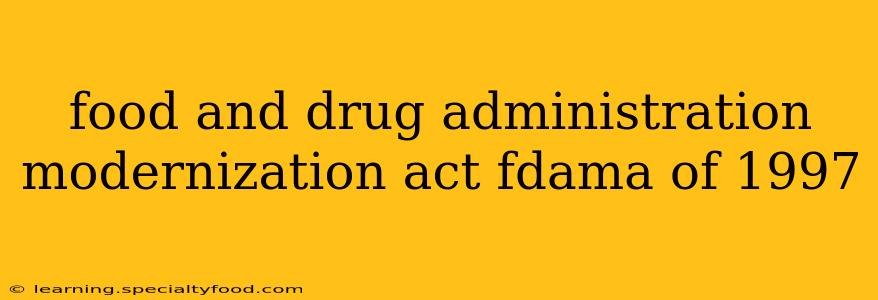The Food and Drug Administration Modernization Act (FDAMA) of 1997 significantly reshaped the landscape of drug and food regulation in the United States. This landmark legislation aimed to streamline the approval process for new drugs and medical devices, enhance the safety and efficacy of medications, and improve the overall efficiency of the Food and Drug Administration (FDA). This comprehensive guide explores the key provisions of FDAMA, its impact on the pharmaceutical and food industries, and its lasting legacy.
What are the key provisions of the FDAMA?
FDAMA encompassed a broad range of changes, affecting various aspects of the FDA's operations. Some of its most significant provisions include:
-
Faster Drug Approval: FDAMA introduced provisions designed to accelerate the approval process for new drugs and biological products, particularly those intended to treat serious or life-threatening conditions. This included the establishment of fast-track approval pathways and incentives for companies to conduct research on neglected diseases.
-
Orphan Drug Designation: The act expanded and strengthened the orphan drug program, providing incentives for the development of treatments for rare diseases affecting small populations. This encouraged pharmaceutical companies to invest in research areas that might otherwise be neglected due to limited market potential.
-
Enhanced Information for Patients: FDAMA mandated improvements in patient information, including requirements for more detailed labeling and the promotion of patient education initiatives. This ensured consumers received clearer and more comprehensive information about the risks and benefits of medications.
-
Dietary Supplements Regulation: The act established regulatory guidelines for dietary supplements, creating a framework for ensuring their safety and preventing misleading claims. This addressed concerns regarding the marketing and labeling of supplements, setting standards for responsible manufacturing and ingredient disclosure.
What was the impact of the FDAMA on the pharmaceutical industry?
The impact of FDAMA on the pharmaceutical industry was profound and multifaceted:
-
Increased Drug Development: The faster approval processes incentivized pharmaceutical companies to invest in research and development, leading to an increase in the number of new drugs brought to market.
-
Focus on Orphan Drugs: The expansion of the orphan drug program fostered the development of treatments for rare diseases, significantly improving the lives of patients with conditions previously lacking effective treatments.
-
Improved Patient Safety: Enhanced labeling requirements and patient education initiatives contributed to improved patient safety by providing clearer information about potential risks and side effects.
-
Increased Competition: The streamlined regulatory pathways created a more competitive market, leading to potential price reductions and greater choice for consumers.
How did FDAMA impact the food industry?
While primarily focused on pharmaceuticals, FDAMA also impacted the food industry, although less dramatically than the pharmaceutical sector. It mainly focused on streamlining certain aspects of food regulation, improving the efficiency of FDA inspections and processes.
What are some criticisms of the FDAMA?
Despite its significant benefits, FDAMA has faced some criticism:
-
Concerns about Accelerated Approval: Some critics argue that the fast-track approval processes may have compromised safety in certain instances by prioritizing speed over thorough review. This remains a topic of ongoing debate and analysis.
-
Dietary Supplement Regulation Gaps: The regulations regarding dietary supplements have been criticized for being insufficient to fully address concerns about the safety and efficacy of these products.
-
Resource Constraints: The increased workload on the FDA resulting from FDAMA's provisions has occasionally led to concerns about resource constraints and potential delays in the regulatory process.
How has FDAMA evolved since its enactment?
Since its enactment, FDAMA has undergone various amendments and interpretations. Subsequent legislation and FDA guidance have further refined the regulatory framework established by FDAMA, addressing challenges and adapting to the evolving landscape of pharmaceutical and food technologies. Ongoing efforts continue to strive for a balance between accelerating innovation and safeguarding public health.
What is the current status of the FDAMA?
The FDAMA remains a cornerstone of US drug and food regulation. While aspects have been amended or further clarified through subsequent legislation and FDA guidance, its core principles continue to shape the FDA's operations and the broader pharmaceutical and food industries.
This analysis provides a comprehensive overview of the FDAMA. Further research into specific aspects, such as the orphan drug program or the details of fast-track approval, would provide a more nuanced understanding. Remember to consult official FDA resources for the most up-to-date information.
